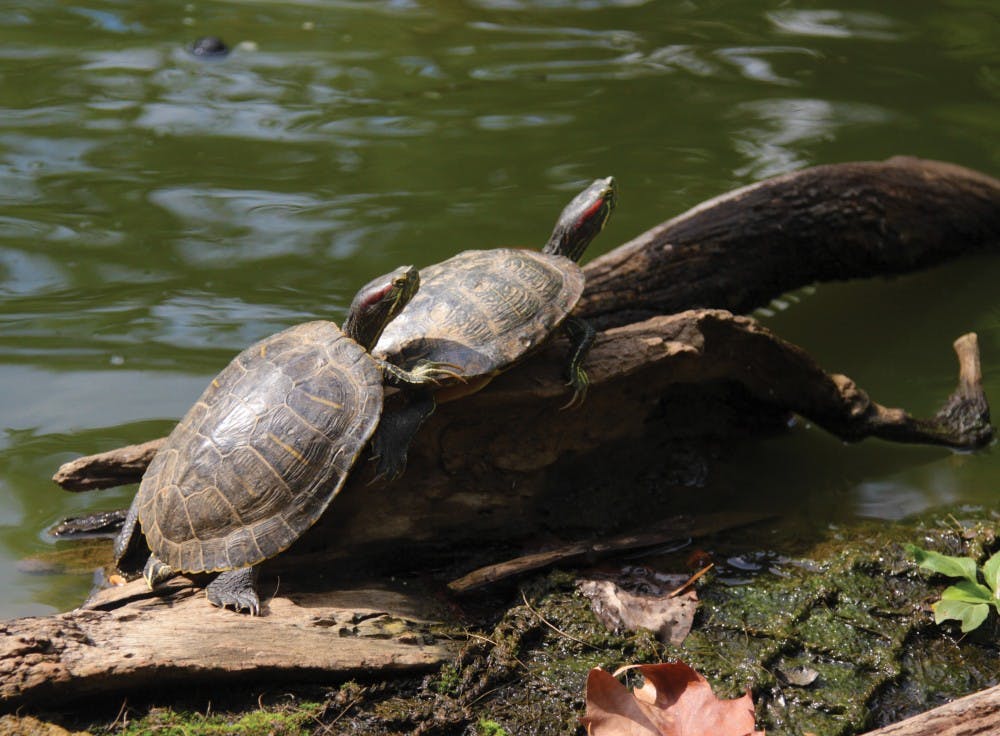After receiving backlash about the plans to euthanize the turtle population of the BioPond, the Kaskey Garden and Greenhouse Committee has changed course, opting to relocate the population to other habitats.
The drainage of the BioPond, the first step in the Committee’s process of restoring the ecological health to the pond without euthanizing the invasive species of turtle that currently live there, was completed on Oct. 27.
All 400 koi fish and 30 of the 75 turtles that the BioPond wasestimated to house were isolated during the drainage, which lasted one week.
The fish were safely transported to a well-aerated pond owned by a volunteer, who agreed to rehouse the koi in Kennet Square. They are being treated with medication and thriving, said Joshua Darfler, the Kaskey Garden and Greenhouse manager.
Scott McRobert, a professor of Biology at St. Joseph’s University and author of an editorial published in The Daily Pennsylvanian suggesting that the Penn Biology Department reconsider its decision to euthanize the turtles, is overseeing the turtle transportation.
McRobert or one of his students will retrieve the captured turtles every day and transfer them to tanks in his lab where they’ll be held until the spring. McRobert is currently surveying different ponds in which to release the turtles when the weather gets warmer. “He’s going to visit each pond first to make sure that they’re not connected to any natural water systems, that there’s not a native turtle already present [and] that the pond is in good health,” Darfler said.
The remaining 45 turtles are buried deep into the muddy floor of the pond, engaged in a process known as brumation, a reptilian version of hibernation that begins in the late fall.
Because it is difficult to access the turtles buried in the mud, the Biology Department will wait until the Spring when the turtles spend more time on the surface of the water to transport them, Darfler said.
In the meantime, the pond will be refilled with city water and aerated before species native to the pond are introduced, which is scheduled for next spring. Plants will also be added in the spring to manage the pond’s nutrient load, an excess of which was attributed to the unpleasant odor emanating from the pond over the summer.
Penn Animal Advocacy, a student-run group, partnered with the Pennsylvania Director of the Humane Society of the United States to persuade the Biology Department to reconsider its options with the turtle population.
Together, they conducted research to assess the validity of the department’s concerns. PAA had some brief email exchanges with members of the Biology Department, but McRobert’s editorial helped change the course of action, Adam Shriver, a member of PAA, said. The group is now involved in the relocating process.
Following McRobert’s editorial, members of the Kaskey Garden Committee opened a dialogue with McRobert to make sure that his solution accounted just as much for the well-being of the turtles as it did for the pond. “We came to an agreement of what we were looking for, criteria-wise, for these ponds, and started a great relationship ever since,” Darfler said.
The pond was to be drained and re-aerated even if the turtles were not to be euthanized.
“As a group...we’re pretty happy with the outcome because we feel strongly that every individual animal’s lives should be respected and something like euthanasia should only be a last resort...
“We’re really happy that the DP article helped facilitate a better solution. On a slightly more critical note, it would be nice if something like euthanasia would be considered as a last resort even without the DP publicity,” Shriver said on behalf of Penn Animal Advocacy.









